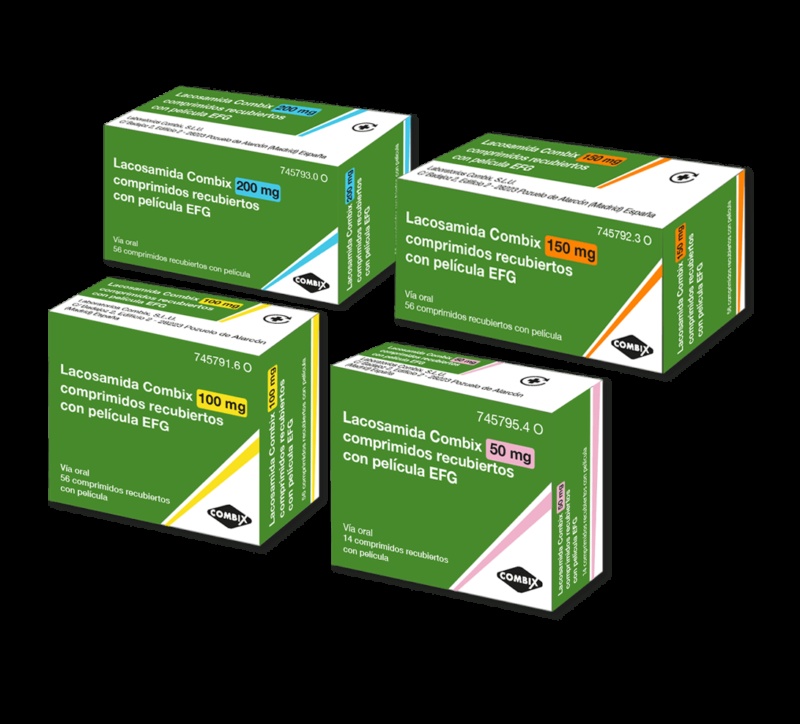

LACOSAMIDA COMBIX 100 mg COMPRIMIDOS REVESTIDOS POR PELÍCULA

Pergunte a um médico sobre a prescrição de LACOSAMIDA COMBIX 100 mg COMPRIMIDOS REVESTIDOS POR PELÍCULA

Como usar LACOSAMIDA COMBIX 100 mg COMPRIMIDOS REVESTIDOS POR PELÍCULA
Introdução
Prospecto: informação para o paciente
Lacosamida Combix 50 mg comprimidos revestidos com película EFG
Lacosamida Combix 100 mg comprimidos revestidos com película EFG
Lacosamida Combix 150 mg comprimidos revestidos com película EFG
Lacosamida Combix 200 mg comprimidos revestidos com película EFG
Leia todo o prospecto atentamente antes de começar a tomar este medicamento, porque contém informações importantes para si.
- Conserva este prospecto, porque pode ter que voltar a lê-lo.
- Se tiver alguma dúvida, consulte o seu médico ou farmacêutico.
- Este medicamento foi prescrito apenas para si e não deve dá-lo a outras pessoas, mesmo que tenham os mesmos sintomas que si, porque pode prejudicá-las.
- Se experimentar efeitos adversos, consulte o seu médico ou farmacêutico, mesmo que se trate de efeitos adversos que não aparecem neste prospecto. Ver seção 4.
Conteúdo do prospecto
- O que é Lacosamida Combix e para que é utilizado
- O que precisa saber antes de começar a tomar Lacosamida Combix
- Como tomar Lacosamida Combix
- Efeitos adversos possíveis
- Conservação de Lacosamida Combix
- Conteúdo do envase e informações adicionais
1. O que é Lacosamida Combix e para que é utilizado
O que é Lacosamida Combix
Lacosamida Combix contém lacosamida, que pertence a um grupo de medicamentos chamados “medicamentos antiepilépticos”. Estes medicamentos são utilizados para tratar a epilepsia.
- Foi prescrito este medicamento para reduzir o número de crises que padece.
Para que é utilizado
- Lacosamida é utilizado:
- sozinho e juntamente com outros antiepilépticos em adultos, adolescentes e crianças a partir de 2 anos para tratar um certo tipo de epilepsia caracterizada pela ocorrência de crises de início parcial com ou sem generalização secundária. Neste tipo de epilepsia as crises afetam apenas um lado do seu cérebro. No entanto, podem então estender-se a zonas maiores em ambos os lados do seu cérebro;
- juntamente com outros antiepilépticos em adultos, adolescentes e crianças a partir de 4 anos para tratar as crises tónico-clônicas generalizadas primárias (crises maiores, com perda de consciência) em pacientes com epilepsia generalizada idiopática (tipo de epilepsia que se acredita ter uma origem genética).
2. O que precisa saber antes de começar a tomar Lacosamida Combix
Não tome Lacosamida Combix
- se é alérgico a lacosamida ou a algum dos outros componentes deste medicamento (incluídos na seção 6). Se não tem certeza se é alérgico, consulte o seu médico.
- se tem um problema do ritmo cardíaco chamado bloqueio AV de segundo ou terceiro grau.
Não tome lacosamida se algum dos anteriores for aplicável no seu caso. Se não tem certeza, consulte o seu médico ou farmacêutico antes de tomar este medicamento.
Advertências e precauções
Consulte o seu médico antes de começar a tomar lacosamida se:
- tem pensamentos de autolesão ou suicídio. Um pequeno número de pessoas em tratamento com antiepilépticos, tais como lacosamida, tiveram pensamentos de autolesão ou suicídio. Se em algum momento tiver este tipo de pensamentos, entre em contato com o seu médico imediatamente.
- tem um problema de coração que afeta o ritmo cardíaco e, com frequência, o seu pulso é especialmente lento, rápido ou irregular (como um bloqueio AV, fibrilação auricular e flutter auricular).
- tem uma doença cardíaca grave, como insuficiência cardíaca ou teve um infarto do miocárdio.
- se mareia ou cai com frequência. Lacosamida pode produzir tontura, o que poderia aumentar o risco de lesões acidentais ou quedas. Isso significa que deve ter cuidado até que esteja acostumado com os efeitos deste medicamento.
Se algum dos anteriores for aplicável no seu caso (ou não tem certeza), consulte o seu médico ou farmacêutico antes de tomar lacosamida.
Se estiver tomando lacosamida, consulte o seu médico se experimentar um novo tipo de crise ou um agravamento das crises existentes.
Se estiver tomando lacosamida e experimentar sintomas de ritmo cardíaco anormal (como ritmo cardíaco lento, rápido ou irregular, palpitações, dispneia (dificuldade para respirar), sensação de tontura, desmaio), consulte com o seu médico imediatamente (ver seção 4).
Crianças
Lacosamida não é recomendado em crianças menores de 2 anos com epilepsia caracterizada pela ocorrência de crises de início parcial, nem em crianças menores de 4 anos com crises tónico-clônicas generalizadas. Isso se deve ao fato de que ainda não se sabe se é eficaz e seguro para as crianças deste grupo de idade.
Outros medicamentos e Lacosamida Combix
Informa ao seu médico ou farmacêutico se está tomando, tomou recentemente ou poderia ter que tomar qualquer outro medicamento.
Em particular, informa ao seu médico ou farmacêutico se está tomando algum dos seguintes medicamentos que afetam o coração, pois lacosamida também pode afetar o coração:
- medicamentos para tratar problemas cardíacos.
- medicamentos que possam aumentar o “intervalo PR” em um exame do coração (ECG ou eletrocardiograma) como os medicamentos para a epilepsia ou a dor chamados carbamazepina, lamotrigina ou pregabalina.
- medicamentos usados para tratar certos tipos de arritmia ou insuficiência cardíaca.
Se algum dos anteriores for aplicável no seu caso (ou não tem certeza) fale com o seu médico ou farmacêutico antes de tomar lacosamida.
Informa também ao seu médico ou farmacêutico se está tomando algum dos seguintes medicamentos, pois também podem aumentar ou diminuir o efeito de lacosamida no seu organismo:
- os medicamentos para as infecções por fungos como fluconazol, itraconazol ou cetoconazol.
- medicamentos para o VIH como ritonavir.
- os medicamentos para as infecções bacterianas como claritromicina ou rifampicina.
- uma planta medicinal que é utilizada para tratar a ansiedade e a depressão leves chamada erva-de-São-João.
Se algum dos anteriores for aplicável no seu caso (ou não tem certeza) fale com o seu médico ou farmacêutico antes de tomar lacosamida.
Toma de Lacosamida Combix com álcool
Como medida de segurança não tome lacosamida com álcool.
Gravidez e amamentação
As mulheres em idade fértil devem falar sobre o uso de anticoncepcionais com o médico.
Se está grávida ou em período de amamentação, acredita que possa estar grávida ou tem intenção de ficar grávida, consulte o seu médico ou farmacêutico antes de utilizar este medicamento.
Não é recomendado tomar lacosamida se está grávida, pois não se conhecem os efeitos de lacosamida sobre a gravidez e o feto.
Não é recomendado amamentar um bebê enquanto toma Lacosamida, porque lacosamida passa para o leite materno.
Pedir conselho imediatamente ao seu médico se está grávida ou planeja ficar grávida. Eles o ajudarão a decidir se deve tomar este medicamento ou não.
Não interrompa o tratamento sem falar antes com o seu médico, pois a epilepsia pode aparecer novamente ou pode piorar.
Condução e uso de máquinas
Não deve conduzir, andar de bicicleta ou usar qualquer ferramenta ou máquinas até que saiba se este medicamento o afeta. O motivo é que lacosamida pode produzir tontura ou visão borrosa.
3. Como tomar Lacosamida Combix
Siga exatamente as instruções de administração deste medicamento indicadas pelo seu médico ou farmacêutico. Em caso de dúvida, consulte novamente o seu médico ou farmacêutico. Outra(s) forma(s) de lacosamida pode(m) ser mais adequada(s) para as crianças; consulte o seu médico ou farmacêutico.
Toma de Lacosamida Combix
- Tome lacosamida duas vezes ao dia, com um intervalo de aproximadamente 12 horas.
- Tente tomar mais ou menos à mesma hora todos os dias.
- Tome o comprimido de lacosamida com um copo de água.
- Pode tomar lacosamida com as refeições ou por separado.
Normalmente, começará a tomar uma dose baixa todos os dias e o seu médico aumentará a dose lentamente ao longo de várias semanas. Quando atingir a dose que funcione bem no seu caso, o que se chama “dose de manutenção”, tomará a mesma quantidade todos os dias. Lacosamida é usado como tratamento a longo prazo. Deverá continuar a tomar lacosamida até que o seu médico lhe diga que o interrompa.
Que quantidade tomar
A seguir são enumeradas as doses normais recomendadas de lacosamida para diferentes grupos de idade e de peso. O seu médico poderia prescrever-lhe uma dose diferente se tiver problemas de rim ou de fígado.
Adolescentes e crianças que pesam 50 kg ou mais e adultos
Quando tome lacosamida sozinho:
A dose de início habitual é de 50 mg duas vezes ao dia.
O seu médico também pode prescrever-lhe uma dose de início de 100 mg de lacosamida duas vezes ao dia.
O seu médico pode aumentar a dose que toma duas vezes ao dia em 50 mg cada semana, até que atinja uma dose de manutenção entre 100 mg e 300 mg duas vezes ao dia.
Quando tome lacosamida com outros medicamentos antiepilépticos:
A dose de início habitual é 50 mg duas vezes ao dia.
O seu médico pode aumentar a dose que toma duas vezes ao dia em 50 mg cada semana, até que atinja uma dose de manutenção entre 100 mg e 200 mg duas vezes ao dia.
Se pesa 50 kg ou mais, o seu médico pode começar o tratamento de lacosamida com uma única dose “de carga” de 200 mg. Então começaria a tomar a dose contínua de manutenção 12 horas mais tarde.
Crianças e adolescentes que pesam menos de 50 kg
- No tratamento das convulsões de início parcial:observe que lacosamida não é recomendada para crianças menores de 2 anos.
- No tratamento das convulsões tónico-clônicas primárias generalizadas:observe que lacosamida não é recomendada para menores de 4 anos.
A dose depende do peso corporal. Normalmente se começa o tratamento com o xarope e só se muda para comprimidos se o paciente é capaz de tomá-los e de obter a dose correta com comprimidos de diferentes concentrações. O médico prescreverá a forma farmacêutica que se ajuste melhor.
Se tomar mais Lacosamida Combix do que deve
Se tomou mais lacosamida do que deve, consulte com o seu médico imediatamente. Não tente conduzir. Pode experimentar:
- tontura;
- sensação de tontura (náuseas) ou tontura (vômitos);
- convulsões (crises), problemas do ritmo cardíaco como pulso lento, rápido ou irregular, coma ou queda da pressão sanguínea com taquicardia e sudorese.
Em caso de sobredose ou ingestão acidental consulte com o seu médico ou ligue para o Serviço de Informação Toxicológica, telefone 91 562 04 20, indicando o medicamento e a quantidade ingerida.
Se esqueceu de tomar Lacosamida Combix
- Se esqueceu de tomar uma dose nas 6 horas seguintes à dose programada, tome-a assim que se lembrar.
- Se esqueceu de tomar uma dose após as 6 horas seguintes à dose programada não tome a dose esquecida, em vez disso, tome lacosamida na próxima vez em que normalmente a tomaria.
- Não tome uma dose dupla para compensar as doses esquecidas.
Se interromper o tratamento com Lacosamida Combix
- Não deixe de tomar lacosamida sem dizer ao seu médico, pois a epilepsia pode aparecer novamente ou pode piorar.
- Se o seu médico decidir interromper o seu tratamento com lacosamida, dar-lhe-á instruções sobre como diminuir a dose gradualmente.
Se tiver alguma outra dúvida sobre o uso deste medicamento, pergunte ao seu médico ou farmacêutico.
4. Efeitos adversos possíveis
Como todos os medicamentos, este medicamento pode produzir efeitos adversos, embora nem todas as pessoas os sofram.
Os efeitos adversos no sistema nervoso, como tontura, podem ser maiores após uma única dose “de carga”.
Informa ao seu médico ou farmacêutico se lhe ocorrer algum dos seguintes efeitos:
Muito frequentes:podem afetar mais de 1 de cada 10 pacientes
- Dor de cabeça;
- Se sentir tonto ou doente (náuseas);
- Visão dupla (diplopia).
Frequentes:podem afetar até 1 de cada 10 pacientes
- Sacudidas breves de um músculo ou grupo de músculos (crises mioclônicas);
- Dificuldade para coordenar os movimentos ou para andar;
- Problemas para manter o equilíbrio, agitação (tremor), formigamento (parestesia) ou espasmos musculares, cair com facilidade e apresentar hematomas;
- Problemas de memória, para pensar ou encontrar as palavras, confusão;
- Movimentos rápidos e incontrolados dos olhos (nistagmo), visão borrosa;
- Sensação de tontura (vertigem), sensação de embriaguez;
- Está tonto (vômitos), ter a boca seca, constipação, indigestão, gás excessivo no estômago ou no intestino, diarreia;
- Diminuição da sensibilidade, dificuldade para articular as palavras, alteração da atenção;
- Ruído no ouvido como um zumbido, apito ou assobio;
- Irritabilidade, problemas para dormir, depressão;
- Sonolência, cansaço ou fraqueza (astenia);
- Coceira, erupção.
Pouco frequentes:podem afetar até 1 de cada 100 pacientes
- Diminuição da frequência cardíaca, palpitações, pulso irregular ou outros cambios na atividade elétrica do coração (distúrbio de condução);
- Sensação exagerada de bem-estar, ver e/ou ouvir coisas que não são reais;
- Reação alérgica à tomada do medicamento, habones;
- Os exames de sangue podem mostrar anormalidades nos testes de função hepática, dano hepático;
- Pensamentos de autolesão ou suicídio ou tentativa de suicídio: informe ao seu médico imediatamente;
- Se sentir zangado ou agitado;
- Pensamentos anormais ou perda da sensação de realidade;
- Reações alérgicas graves, que provocam inchaço da face, garganta, mãos, pés, tornozelos ou das zonas baixas das pernas;
- Desmaio;
- Movimentos involuntários anormais (discinesia).
Frequência não conhecida:não pode ser estimada a partir dos dados disponíveis
- Ritmo cardíaco anormalmente rápido (taquiarritmia ventricular);
- Dor de garganta, temperatura elevada e apresentar infecções com mais frequência do que o normal. Os exames de sangue podem mostrar uma diminuição grave de uma classe específica de glóbulos brancos (agranulocitose);
- Reação cutânea grave, que pode incluir temperatura elevada e outros sintomas pseudogripais, sarpullido na face, sarpullido generalizado com inflamação ganglionar (ganglios linfáticos aumentados). Os exames de sangue podem mostrar aumento dos níveis de enzimas hepáticas e um aumento em um tipo de glóbulos brancos (eosinofilia);
- Uma erupção generalizada com bolhas e descamação da pele, especialmente ao redor da boca, nariz, olhos e genitais (síndrome de Stevens-Johnson) e uma forma mais grave que causa descamação da pele em mais de 30% da superfície corporal (necrólise epidérmica tóxica):
- Convulsões.
Outros efeitos adversos em crianças
Os efeitos adversos adicionais observados em crianças foram febre (pirexia), moqueo nasal (nasofaringite), dor de garganta (faringite), comer menos do que o habitual (diminuição do apetite), mudanças de comportamento, não agir como normalmente (comportamento anormal) e falta de energia (letargia). A sensação de sono (sonolência) é um efeito secundário muito frequente nas crianças e pode afetar mais de 1 de cada 10 crianças.
Comunicação de efeitos adversos
Se experimentar qualquer tipo de efeito adverso, consulte o seu médico ou farmacêutico, mesmo que se trate de possíveis efeitos adversos que não aparecem neste prospecto. Também pode comunicá-los diretamente através do Sistema Espanhol de Farmacovigilância de medicamentos de Uso Humano: https://www.notificaram.es. Mediante a comunicação de efeitos adversos, você pode contribuir para fornecer mais informações sobre a segurança deste medicamento.
5. Conservação de Lacosamida Combix
Mantenha este medicamento fora da vista e do alcance das crianças.
Não utilize este medicamento após a data de validade que aparece na caixa e blister, após CAD. A data de validade é o último dia do mês que se indica.
Este medicamento não requer condições especiais de conservação.
Os medicamentos não devem ser jogados fora pelos esgotos nem pela lixeira. Deposite os envases e os medicamentos que não precisa no Ponto SIGRE da farmácia. Em caso de dúvida, pergunte ao seu farmacêutico como se livrar dos envases e dos medicamentos que não precisa. Dessa forma, ajudará a proteger o meio ambiente.
6. Conteúdo do envase e informação adicional
Composição de Lacosamida Combix
- O princípio ativo é lacosamida.
Cada comprimido de Lacosamida Combix 50 mg contém 50 mg de lacosamida.
Cada comprimido de Lacosamida Combix 100 mg contém 100 mg de lacosamida.
Cada comprimido de Lacosamida Combix 150 mg contém 150 mg de lacosamida.
Cada comprimido de Lacosamida Combix 200 mg contém 200 mg de lacosamida.
- Os outros componentes são:
Núcleo do comprimido:Celulosa microcristalina, crospovidona, hidroxipropilcelulosa, sílica coloidal anidra e estearato de magnésio.
Revestimento:
50 mg: Opadry branco 03F58750, composto por: hipromelosa, dióxido de titânio (E171), macrogol e talco.
100 mg: Opadry amarelo 03F520087, composto por: hipromelosa, dióxido de titânio (E171), macrogol, talco, óxido de ferro amarelo (E172) e óxido de ferro vermelho (E172).
150 mg: Opadry bege 03F570004, composto por: hipromelosa, dióxido de titânio (E171), macrogol, talco, óxido de ferro amarelo (E172), óxido de ferro vermelho (E172) e óxido de ferro preto (E172).
200 mg: Opadry azul 03F505020, composto por: hipromelosa, dióxido de titânio (E171), macrogol, talco, índigo carmim (E132), óxido de ferro vermelho (E172) e azul brilhante FCF (E133).
Aspecto do produto e conteúdo do envase
Lacosamida Combix 50 mg são comprimidos revestidos com película ovais, de cor branca ou esbranquiçada, com bordos biselados, marcados com “787” em uma face e lisos por outra, com dimensões aproximadas de 10 mm x 5 mm.
Os comprimidos são apresentados em blisteres envasados em caixas de 14 comprimidos.
Lacosamida Combix 100 mg são comprimidos revestidos com película ovais, de cor amarela ou amarelada, com bordos biselados, marcados com “788” em uma face e lisos por outra, com dimensões aproximadas de 13 mm x 6 mm.
Os comprimidos são apresentados em blisteres envasados em caixas de 56 comprimidos.
Lacosamida Combix 150 mg são comprimidos revestidos com película ovais, de cor bege, com bordos biselados, marcados com “789” em uma face e lisos por outra, com dimensões aproximadas de 14 mm x 7 mm.
Os comprimidos são apresentados em blisteres envasados em caixas de 56 comprimidos.
Lacosamida Combix 200 mg são comprimidos revestidos com película ovais, de cor azul clara ou azul, com bordos biselados, marcados com “790” em uma face e lisos por outra, com dimensões aproximadas de 16,2 mm x 7,9 mm.
Os comprimidos são apresentados em blisteres envasados em caixas de 56 comprimidos.
Titular da autorização de comercialização
Laboratórios Combix, S.L.U.
Rua Badajoz 2, Edifício 2
28223 Pozuelo de Alarcón (Madrid)
Espanha
Responsável pela fabricação
Zydus France
ZAC Les Hautes Patures
Parc d'activités des Peupliers
25 Rue des Peupliers
92000 Nanterre
França
ou
Centre Spécialités Pharmaceutiques
ZAC des Suzots
35 rue de la Chapelle
63450 Saint Amant Tallende
França
ou
Netpharmalab Consulting Services S.L.
Estrada de Fuencarral 22
28108 Alcobendas, Madrid
Espanha
ou
Pharmex Advanced Laboratories S.L.
Estrada A-431 Km. 19
14720 Almodóvar del Río (Córdoba)
Espanha
Data da última revisão deste prospecto: Julho 2022
A informação detalhada e atualizada deste medicamento está disponível na página Web da Agência Espanhola de Medicamentos e Produtos Sanitários (AEMPS) http://www.aemps.gob.es/

Quanto custa o LACOSAMIDA COMBIX 100 mg COMPRIMIDOS REVESTIDOS POR PELÍCULA em Espanha em 2025?
O preço médio do LACOSAMIDA COMBIX 100 mg COMPRIMIDOS REVESTIDOS POR PELÍCULA em dezembro de 2025 é de cerca de 65.78 EUR. Os valores podem variar consoante a região, a farmácia e a necessidade de receita. Confirme sempre com uma farmácia local ou fonte online para obter informações atualizadas.
- País de registo
- Preço médio em farmácia65.78 EUR
- Substância ativa
- Requer receita médicaSim
- Fabricante
- Esta informação é apenas para referência e não constitui aconselhamento médico. Consulte sempre um médico antes de tomar qualquer medicamento. A Oladoctor não se responsabiliza por decisões médicas baseadas neste conteúdo.
- Alternativas a LACOSAMIDA COMBIX 100 mg COMPRIMIDOS REVESTIDOS POR PELÍCULAForma farmacêutica: COMPRIMIDO, 100 mgSubstância ativa: lacosamideFabricante: Intas Third Party Sales 2005 S.L.Requer receita médicaForma farmacêutica: COMPRIMIDO, 150 mgSubstância ativa: lacosamideFabricante: Intas Third Party Sales 2005 S.L.Requer receita médicaForma farmacêutica: COMPRIMIDO, 200 mgSubstância ativa: lacosamideFabricante: Intas Third Party Sales 2005 S.L.Requer receita médica
Alternativas a LACOSAMIDA COMBIX 100 mg COMPRIMIDOS REVESTIDOS POR PELÍCULA noutros países
As melhores alternativas com o mesmo princípio ativo e efeito terapêutico.
Alternativa a LACOSAMIDA COMBIX 100 mg COMPRIMIDOS REVESTIDOS POR PELÍCULA em Polónia
Alternativa a LACOSAMIDA COMBIX 100 mg COMPRIMIDOS REVESTIDOS POR PELÍCULA em Ukraine
Médicos online para LACOSAMIDA COMBIX 100 mg COMPRIMIDOS REVESTIDOS POR PELÍCULA
Avaliação de posologia, efeitos secundários, interações, contraindicações e renovação da receita de LACOSAMIDA COMBIX 100 mg COMPRIMIDOS REVESTIDOS POR PELÍCULA – sujeita a avaliação médica e regras locais.







